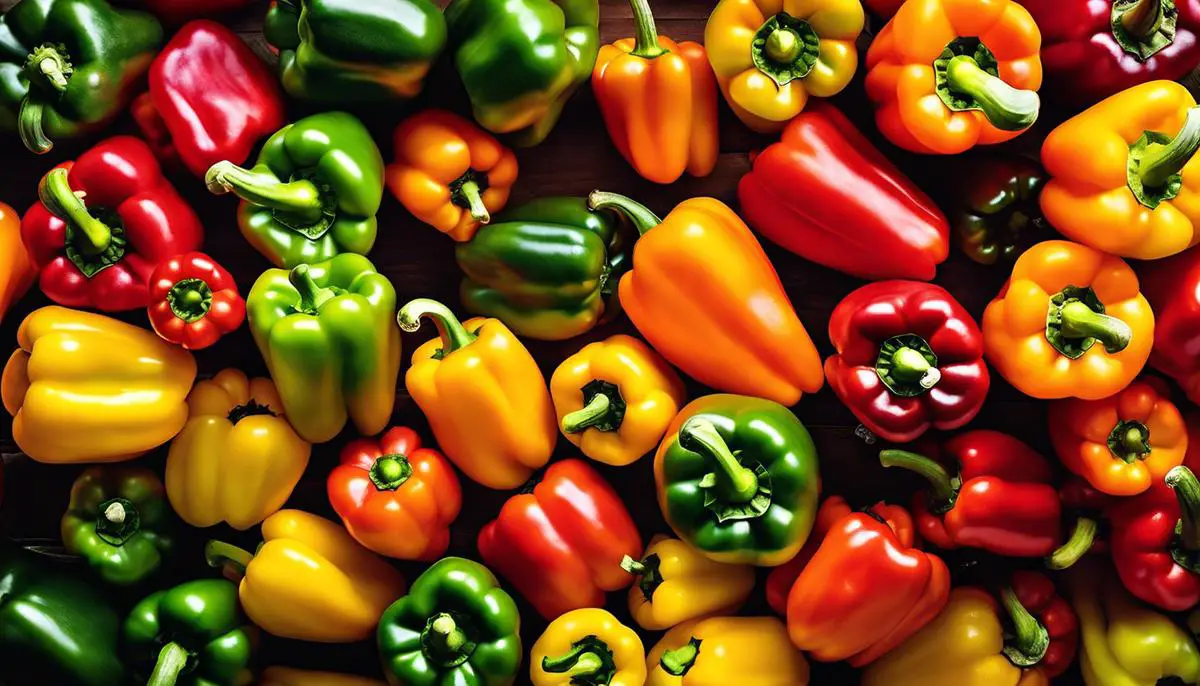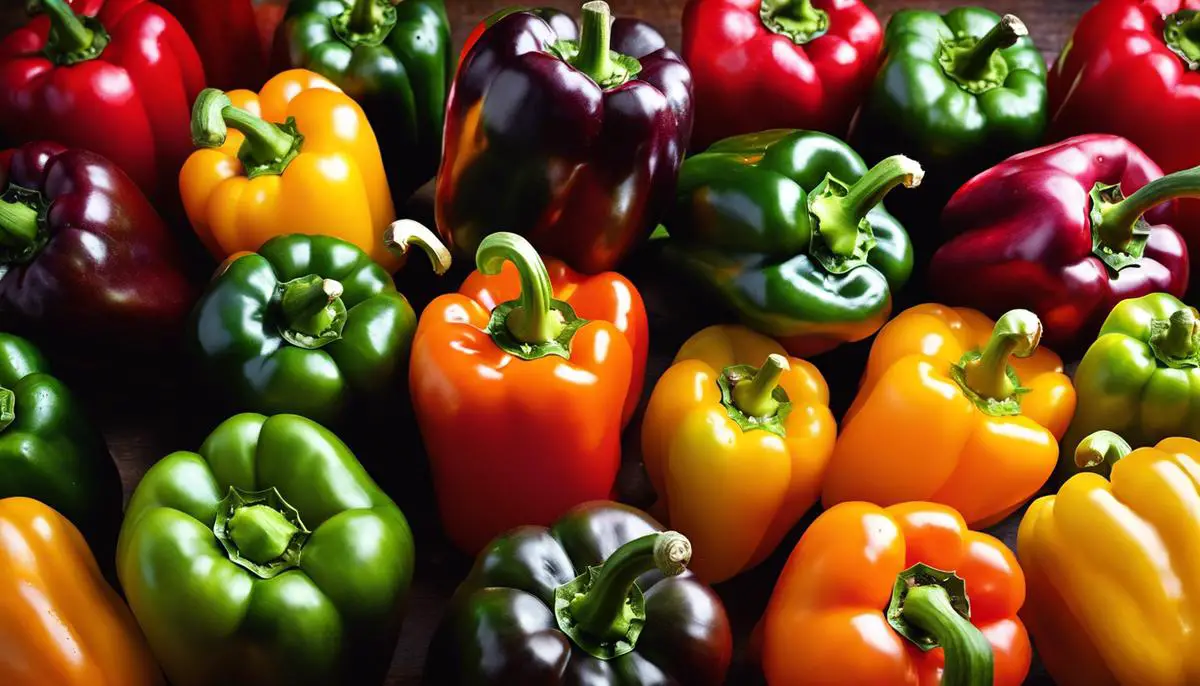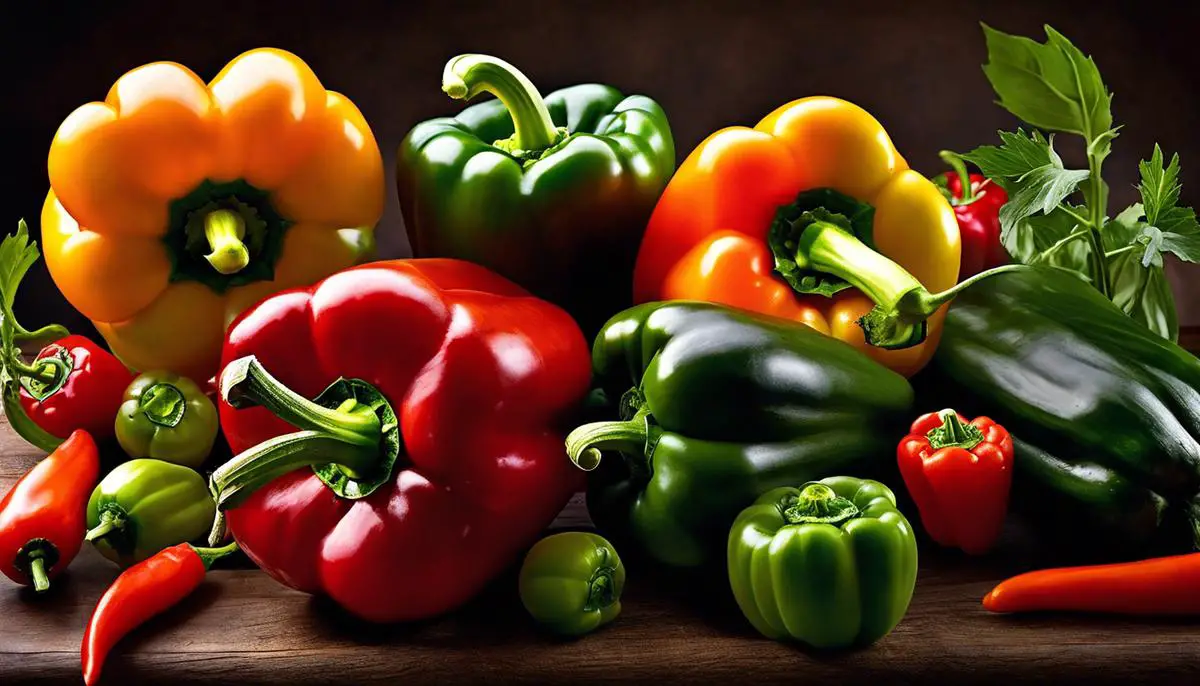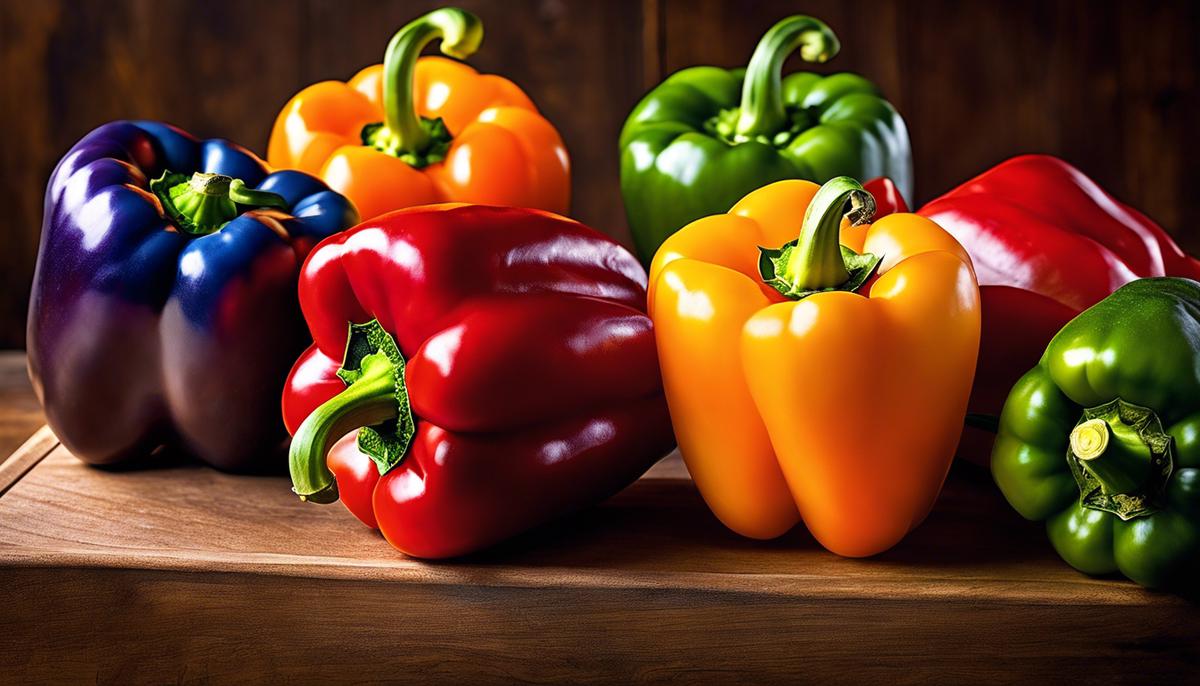Colored and captivating, bell peppers are a remarkable blend of vibrant appearance and radiant nutrition. Drawing from several cultures’ kitchen traditions, these lively vegetables not only create a culinary spectacle but also pack an impressive nourishing punch. Regardless of their color – be it green, yellow, orange, or red – each bell pepper sings its unique song of taste and health benefits. This enlightening exploration will traverse the color spectrum of bell peppers, uncover their health benefits, visit their culinary applications, and witness their growth and harvesting process – all to appreciate the unfolding of these edible gems from farm to fork.
Understanding the Different Colors of Bell Peppers
Dive into a World of Colors with Bell Peppers!
Reader Poll: What online courses would interest you?
To the unassuming visitor in a produce aisle, bell peppers may simply seem like colorful options for your salad bar. However, those striving culinary enthusiasts among us understand there’s much more to decipher from these vibrantly dressed veggies. In fact, the color spectrum of bell peppers can unlock culinary insights and beckon a hearty, healthful feast!
Ranging from resplendent green to vivacious red, and sporting shades of yellow, orange, and even purple or brown, a variety of bell peppers exist. The whole reason behind this spectrum isn’t just to impress with color, but to signify the different stages of ripeness and consequent changes in taste, nutrition content, and cooking suitability.
Starting with green bell peppers, these are the unripened ones. They offer a somewhat bitter flavor, but their firm texture suits them perfectly for sizzling stir-fries or zesty stuffed peppers. Green bell peppers lead the pack in terms of affordability, simply because they require a shorter time to harvest.
Subscribe to our newsletter!
Then come yellow and orange bell peppers, which are essentially in the middle of the ripening process. They offer a delightful blend of slight sweetness and a little crunch, making them ideal for salads, ratatouille or as fresh additions to your pasta.
Enter the red bell peppers – these are fully ripened and carry a sweet and mildly fruity taste. This full ripeness also makes them a cornucopia of health benefits. Red bell peppers hold more than double the vitamin C of their green counterparts and a great source of beta carotene, boosting your immune health and vision.
For the daring palate, there are even purple, brown, and white bell peppers, which are less common but still worthy of exploration. Each enrobe unique flavors, from earthy to sweet, broadening the culinary horizon.
The best part? Bell peppers of all colors, flavours, and ripeness are incredibly versatile. Grilled, roasted, sautéed, or simply enjoyed raw, these bountiful crops adapt seamlessly into a variety of cuisines. They are the silent heroes that enhance a dish’s flavor, texture, and visual appeal.
So, what are we waiting for? Let’s grab a handful of these brightly clad, crisp wonders and heighten our culinary experience! The world of bell peppers is a dazzling venture too tempting to resist. As they say – beautiful meals are a feast not just for the stomach, but for the eyes as well!

Bell Peppers and Health Benefits
Beyond the colorful display and versatile role in various dishes, bell peppers also boast an impressive nutritional portfolio that sets them apart in the culinary realm. A harmonious blend of great tastes and striking health benefits, they’re a delightful way to turn up the health factor in your meals.
Let’s delve into why these culinary gems are not just a feast for the eye and palate, but also a boon for our well-being.
Firstly, bell peppers are low in calories yet rich in dietary fiber, making them an ideal food for those watching their waistlines. A cup of chopped bell peppers contains just around 45 calories but provides nearly 2 grams of fiber. Not only does this help in managing weight, but fiber also contributes to better digestion, helps maintain blood sugar levels, and lowers cholesterol levels.
Bell peppers are also a powerhouse of antioxidants, substances that can help protect your cells from damage. One of these antioxidants, lycopene, is prevalent in red bell peppers. It’s been studied for its potential to help prevent certain types of cancers, particularly those of the prostate.
While we’ve already highlighted their beta carotene and vitamin C content, these glossy orbs have more to offer. They’re also a good source of Vitamins E, K1, B6, and folate. Vitamin B6 and folate are essential for many body functions, with a particular role in heart health given their ability to reduce high homocysteine levels in the blood.
Moreover, vitamins E and K1 present reinforce the value of bell peppers even further. Vitamin E is known for its beauty benefits, promoting healthy skin and hair. Meanwhile, vitamin K1 plays a crucial role in blood clotting and bone health.
Bell peppers also introduce a modest, yet significant, hustle of minerals. This includes a dance of magnesium, manganese, and potassium, all vital for normal body function. These minerals support metabolism, bone health, and overall body electrolyte balance.
The potential to zest up a dish coupled with a slew of body-loving nutrients makes bell peppers an essential cornerstone in the edible realm. They are more than just a crunchy, sweet addition to your salads, stir-fries, or grilled meat; they’re a culinary and nutritional champion that deserves the center stage. Next time you chop up a bell pepper, you’re not just adding flavor, you’re also providing an upswing of health and well-being to your meal. So don’t shy away from packing your plates with these vibrant veggies; your taste buds and body will thank you.

Culinary Uses of Bell Peppers
The exuberant riot of colors that bell peppers bring to the table is a feast for the eyes, laying the bedrock for an amazing gustatory experience! In this symphonic mix, let’s embark on a flavor recital, exploring complex chords of taste and mouthfeel that bell peppers can masterfully introduce in different food arrangements.
Bell peppers can artfully elevate simple dishes, offering a canvas for vibrant colors, crisp texture, and diverse flavors. A hearty vegetable lasagna can transform into a painter’s palette with layers of thinly sliced red, green, and yellow bell peppers, each lending their distinct sweet to moderately bitter flavors. Their firm structure and mild flavor profile make them excellent vehicles for stuffing, capable of cradling anything from spicy jalapeno cornbread to Mediterranean quinoa salad, or even seafood jambalaya.
Pairing bell peppers with proteins is also a culinary delight, slotting in seamlessly to the protein’s flavor profile. Chicken or tofu stir-fry, for instance, can get a flavor and color boost with stripes of bell peppers dancing among the chunks of protein. Similarly, a grilled steak can be complemented with red bell pepper chimichurri, the slightly sweet and fruity flavor of the pepper partnering beautifully with savory grilled meats.
Even in the domain of liquid foods, bell peppers don’t shy away. Witness a red bell pepper soup acting as a showcase for its sweet and vibrant profile. Its pigment lends a spectacular color to the soup while the gentle cooking draws out its innate sweetness.
Bell peppers can also steal the limelight in pasta dishes. A pasta primavera richly studded with colorful bell peppers is not just visually stunning but a bounty of flavors. Here, the peppers’ role graduates from being a humble supporting act to an equal star sharing the flavor credit with the pasta.
Similarly, pizzas, the universal comfort food, can be upgraded with bell peppers. Their crisp texture, when thrown onto a baking hot pizza, subtly caramelizes the edges while retaining a desirable crunch, elevating the humble pizza to gourmet status.
Bell peppers also play well in salads, their vivid colors brightening up the plate, adding a note of freshness and crunch. In a Greek salad, the bell peppers commingle with feta, cucumber, tomatoes, and olives, making every mouthful a delightful medley of taste.
Not just confined to savory dishes, bell peppers find usage in desserts too. Bell pepper jam may sound eclectic, but its distinctive sweet taste can create a dessert, which is truly novel.
A simple vegetable, yet so diverse, the humble bell pepper carries a whole gamut of possibilities in its vibrant coat. Experiment with bell peppers for your next kitchen adventure, and let the aroma, flavor, and color take you on unforgettable culinary roads. Let the borders of traditional cooking dissolve and unearth the true potential of bell peppers in enriching, electrifying, and enlivening your dishes.

Growing and Harvesting Bell Peppers
The Epic Journey of Bell Peppers: From Seed to Savoring
Bell peppers, those vibrant stars of the culinary world, go on quite a journey from seed to plate. The life of these brightly-hued wonders begins serenely, nestled within the warm sanctuary of nutrient-rich soil. With the right combination of light, moisture, and temperature, these seeds germinate and gradually book their place into the world, bringing forth fragile shoots that eventually grow into robust plants.
As these plants stand basking in the sunlight, they are busy producing fruits, our familiar bell peppers. This process involves an intricate dance of pollination, typically carried out by insects or wind, leading to the development of the tiny, green peppers that are soon to command our culinary imagination. Covered by large leafy canopies, they mature in the palms of nature, their skins transitioning from a lush green to a vibrant spectrum of colors, as defined by their variety and level of ripeness.
Now, think about bell peppers in global gastronomy – they are simply essential. From the peppery delight of Asian stir-frys to the smoky allure of Spanish Romesco sauce, few ingredients boast such culinary passport! Bell peppers even transcend culinary boundaries, bursting onto the snack scene as a crunchy, nutritious alternative to calorie-rich delights.
And can we talk about roasting? The high heat of roasting works magic, transforming the raw crunch to a smoky, tender delight, with an enhanced sweetness that expands their gastronomic potentials. Imagine them making a grand entrance to roasted veggies, pizzas or as an irresistible, velvety soup – pure bliss! Not forgetting their prowess in grilling, stuffed with protein or intricate grains, and graced with aromatic spices. Pursue this delectable route, and you’ll be rewarded with a mouthful of charred exterior and alluring, molten interior.
Bell peppers even extend their charm to the world of desserts. Ever tried a bell pepper jam? With their inherent sweetness highlighted by slow-cooking and augmented with sugar, they are transformed into a tangy, delicate spread capable of livening up any humble piece of toast or adding a surprising spark to your frozen delights like ice cream or cheesecakes.
As our bell pepper fervor reaches a crescendo, there’s a quiet appreciation. An appreciation for the humble seed that was the inception, for the journey traversed by bell peppers, and for the stories they’ve shared with every dish they’ve kissed. Enlightening our palettes and delighting our senses, bell peppers are, indeed, a culinary marvel we’re lucky to savor. As we take a moment to admire their beauty, their vibrant hues that dress our plates, and the incredible flavors they inject into our meals, we realize the journey from seed to plate isn’t just about growth and maturation. It’s about the magic of transformation and gastronomical adventures waiting to be experienced. Bon Appétit!

Appreciating bell peppers in their full glory transcends beyond merely sprucing up our plates and palates. It encompasses recognizing the exceptionality they bring to our nutritional table, acknowledging their wide-ranging culinary applications, and understanding the dedicated farming practices behind their cultivation. From their vibrant green youth to their maturing shades of yellow, orange, or red, each color stage of bell peppers offers a unique blend of flavors and nutrients. Their dazzling colors indeed offer a meaningful culinary experience, but their multitude of health benefits makes them a prized ingredient. Next time you pick up a bell pepper, remember you’re holding a piece of culinary and nutritional artistry nurtured from seed to harvest.

